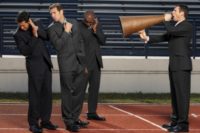 ISHN conducted an exclusive interview with Aubrey Daniels, founder of Aubrey Daniels International, who presented a talk at ASSE Safety 2014 on “What Works Best Doesn’t Come Naturally: Leadership Actions for Preventing Loss.”
ISHN conducted an exclusive interview with Aubrey Daniels, founder of Aubrey Daniels International, who presented a talk at ASSE Safety 2014 on “What Works Best Doesn’t Come Naturally: Leadership Actions for Preventing Loss.”
ISHN: You say in your proceedings paper, “It’s time that senior leaders recognize the key role they play in preventing Serious Injuries and Fatalities.” Isn’t past time? OSHA, the modern safety movement, is 40+ years old. You cite widely publicized calamities. Why do many leaders continue to “not get it,” not step up to the plate for safety, to own up to their role and responsibilities?
Aubrey Daniels: One of the primary reasons is that safety is really all about behavior, it’s essential that managers and senior managers understand the science of behavior. Positive reinforcement is not simply patting someone on the back. When senior management doesn’t understand behavior, they can’t develop policies and procedures. Like you say in your question, when is someone going to realize what we’ve been doing for 40 years is not working?
Punishment creates a lot of problems for how people go about their behavior. In the VA scandal, punishment is driving a lot of what is happening. In the VA, they haven’t learned -- never reward a result without understanding the behavior that created it. Many organizations don’t understand this.
Behavior-based safety focuses on behavior that creates results. You can’t look at lagging indicators. Observations are an essential part of what’s going on. Senior executives can’t read an injury report and understand what’s going on down on the floor. On the TV show “Undercover Boss,” the bosses are aghast at what they see when they get in the workplace. When the numbers come in, well, you never see behavior from the numbers. You have got to observe the behaviors.
If bad news doesn’t travel up the chain of command, punishment is occurring somewhere. No one needs to be trained to know how to punish, but they do need to learn how to reinforce positively.
Another thing that’s not right is this: telling somebody something is not the definition of training. Show a movie, give a test, tell them how to be safe -- that’s necessary but that’s not training. How long will I remember what I saw on a video? It takes much more practice to develop safety habits than what people understand.
Take lone workers; you cannot create a safe employee unless they’ve been taught to a level of automatic fluency, automatic behaviors. We have to train people to use positive reinforcement the right way. To create a habit that survives distractions and remains consistent -- that takes much, much more positive reinforcement that people allow.
Why do you say the impact of many organizational systems on safety is unknown and unplanned?
A system or process never saved a life, or kept people from hurting themselves. A process is the antecedent to tell people what to do, you need the consequences. Again, it comes back to observe people in what they’re doing to provide correction and support for what they’re doing right. To keep a habit strong, a process doesn’t do that automatically.
What is an example of a slight adjustment in a leader’s daily routine, as you say, that can have a positive impact on safety?
Many times if a senior leader walks through a plant, I’ve seen this over and over again, acknowledging everybody going by, if someone doing the wrong thing, this is not the time to say ”Hi, how are you doing?” Leaders must be aware of the impact of their behavior on others’ behavior. Look for what’s going right instead of the problem. That’s a slight adjustment; it doesn’t take special talent.
You say leaders must avoid reacting negatively to bad news. Isn’t that human nature? Don’t we all respond that way?
The natural thing is the wrong thing. It’s the old problem of punishing the messenger. Punishment flows downhill. You punish me, I’ll punish someone else. So the reaction is, people will hide things to avoid punishment. What I want to do is provide support. If you catch someone doing something wrong, ask, “Do you know what the right thing is? Do I need to show you? Do you need support? What can I do to help you?” The senior executive’s role is to support the right things. If you see the wrong thing being done, we miss an opportunity to do the thing correctly. How can we go back and fix that?
The measure of the leader is the behavior of the follower. If I go out in the plant, what I see is the reflection of what we’ve created in this working environment. Most of the time we didn’t intend to do create problems. Fix the environment and you fix behavior most of the time.
In your experience, if a safety director talks to a senior leader about leading and lagging safety indicators, does the leader know what the safety director is talking about?
I think many don’t know. Most of the communication with senior executives has to be very concrete -- this is what is causing the number of injuries to go up, now what can we do to address these behaviors?
What is one of your favorite leading indicators?
The leading indicators are what people are doing every day. When we go out in the plant, we’re looking for people doing things correctly. The gap between what is being done safely and what is not being done safely is what needs to be fixed.
People don’t understand what it will take to get a behavior that is done wrong to be done right. In the BP Gulf disaster, workers received safety awards the day of the disaster. I submit they weren’t safe for a day. The managers weren’t good at observing if employees were doing the right or wrong thing.
In most places, employees won’t say this is what I did wrong. Near miss reports go up when you say, “We need to know about close calls. I want to know. I need to know if somebody makes a mistake.” Instead the executive says you’re fired. “Well, I did something, I fired him,” he says.
You should say, “I really appreciate you reporting that because it will really help me correct the situation. It helps me to know that.” Make the chance remote for jumping on a person.
You mention culture often in your paper -- the need for a culture of candor and trust. In your experience, have you found corporate cultures and the same company’s safety culture to be the same or different? Aren’t they directly, organically connected… for better or worse?
Often they’re different because the safety director is doing BBS, creating positive consequences, in the face of a negative culture. Often the cultures are the same. Safety can have a negatively-oriented culture (blame, punishment) like the overall culture. Pay good wages and people think they have a positive culture. But the culture can be negative if people are afraid of getting caught making a mistake or doing something wrong.
A department manager can create a positive culture in his or her department, but if he’s faced constantly by negative consequences coming down from top, usually that manager will quit, he’ll get tired of fighting.
What can a manager do faced with that situation? You have to absorb a certain amount of punishment. You try to teach every person that we’re all responsible for what happens here. We need to reinforce positive behavior when you see improvement. Give support, and let it be known that we’re going to do our part to help people, Help is important. And use positive consequences. Don’t take it for granted that people will do what you want.
Leadership creates the environment in which behavior takes place. If there is a problem, it goes back to the environment created, the processes, systems, and behavior. It is the responsibility of each of us to coach, to support people to do the right thing. If you see somebody doing the wrong thing, try to create a behavior you can reinforce positively.









